Across the Nullarbor, Part 1
Howdy! I’m in Perth after a nine-day trip that included the Eyre Peninsula, the desolate Nullarbor Plain and the forests of southwest Western Australia. The tour was everything I hoped for and a little more.
I came to Australia with the goal of crossing the Nullarbor. A solo traveler’s options for the Nullarbor are limited. Trains and buses make the journey in two days. You can rent a car and drive yourself. Or there’s the Nullarbor Travelller, a private tour company offering a nine-day tour from Adelaide to Perth with a few adventures along the way. I decided this was the best for me and signed up.
The world Nullarbor comes from the Latin Nullus Arbos, meaning treeless plain. The actual area of the Nullarbor that is treeless is just a fraction of the whole, but the area is still dry, hot and remote. It is the world’s largest, flattest piece of limestone, covering an area or approximately 200,000 square meters. The Aboriginal word for the region means “place without water.” Even today, large swaths of the Nullarbor generate their own electricity (from solar or wind power) and subsist on reserves of rainwater.
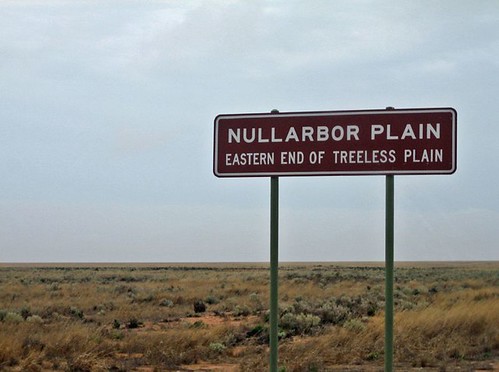
DAY ONE
The tour began with a 7 a.m. pickup at my hostel in Adelaide. The guide and driver is Kylie, a former hairdresser who decided to change careers and in her early 30’s finished high school, went to college for a degree in biodiversity and conservation and is now working as a guide until she can become a park ranger. Kylie dislikes of the city, “The Big Smoke” she calls it, and I can tell she is itching to get on the road. Her enthusiasm is infectious and soon her seven passengers are settled in for the adventure ahead.
Over the next nine days we will cover nearly 4,000 kilometers (2,500 miles), traveling through mountain ranges, coastal towns, desolate desert and old-growth forest.
We head north on A1, past farmland and dry salt lakes before reaching sleepy Port Germein to pick up our trailer – food, gear and general necessities for the road ahead. A few kilometers out of town we see the lower reaches of the Southern Flinders Ranges. Australians call these mountains, but with the highest peaks topping out at about 1,200 meters, most people (me, for one) would call them hills.
We stop at Mr. Remarkable for a short bushwalk while Kylie prepares lunch. It is here that I spot my first live kangaroos, unremarkable specimens we spook on the trail. I’ve seen plenty or ‘roos on film, but until I’d seen them hop with my own eyes, I didn’t understand the power of their legs and the grace with which they move. I have also learned (courtesy of the Lonely Planet guidebook) that the hopping motion assists in breathing, as the up and down motion jostles the intestines, which in turn pump the bellows of the lungs. After two weeks in Australia, I am happy to finally see these creatures. There will be many more before we reach Perth, but this is a load off my mind.
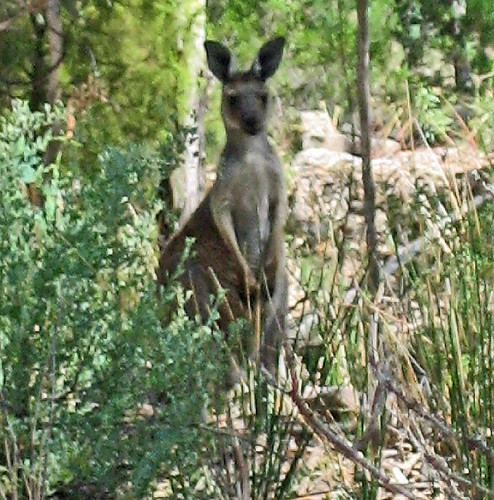
The afternoon also brings a change in scenery. The white limestone so prevalent on the coast gradually turns to a coppery red as we enter the inconsequential town of Port Augusta, once the center of the country’s mining industry. The town is also called the crossroads of Australia, with railroad and automobile routes north to Alice Springs and Darwin and west to Perth passing through. A quick stop for fuel and supplies (an overpriced bottle of Jack Daniels for me), we head to the defunct mine at Iron Knob.
With almost 800 kilometers to cover on the first day, I assume the tour’s operators wanted to break up the journey with something, with anything. What we get is a visit to the mine at Iron Knob. The town once housed 3,000 souls, but the land has been stripped bare and Iron Knob is little more than a historical curiosity. The visit is not something I would ever do on my own, but I enjoyed seeing a mine pit and the old machinery.
Next up is a short stop in Kimba, a town exactly halfway across the continent, for photos with another example of Australia’s oversized statues. This time it’s the big galah, a native bird with a shocking red breast. We also get our first look at road trains, the semi trucks carrying two or more trailers that ply Australia’s highways and dirt tracks. Road trains once carried up to seven trailers but are now limited to three on sealed roads and four on country tracks. At a Mobile Station outside of Kimba, the sign advertises the availability of petrol rather than the price.
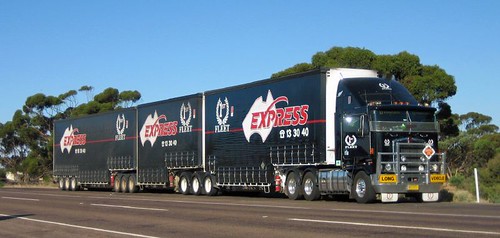
We set up camp at Polda Rock, outside of Widunna. With a small group, there are tents for everyone and I am happy to know I will have a private room every night for the next week.
DAY TWO
The next morning, we drive an hour to Baird Bay, a protected cove where we sign up for the Baird Bay Ocean Eco Experience. It costs an extra $100 AUD, but I’m not about to pass up the chance to with wild sea lions and dolphins. The dolphins are skittish and swim away after about a minute, but the sea lions are happy to swim and play for about 40 minutes. (Click here for a detailed post on the swim).
After lunch on the beach in Baird Bay, we head to the geologic oddity Murphy’s Haystacks, where huge hunks of granite have been left exposed after hundreds of thousands of years of erosion. Good for pictures and the young geologist on the tour, but in the end not more than a curiosity. Kyle took me into the toilet to see a black widow, but it wasn’t in there, just egg sacks and a puny male.
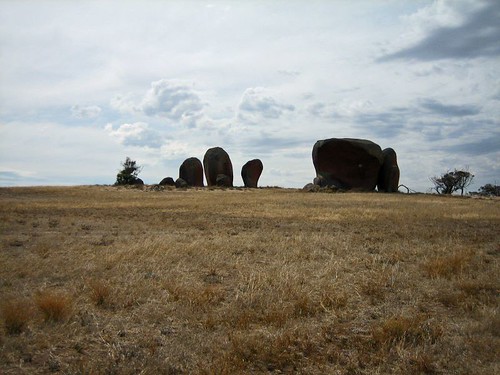
The final activity of the day was a walk along the limestone cliffs at Venus Bay to see petrified trees, from a time when Australia and Antarctica were one landmass. Kylie also offered a lesson in identifying animal tracks in the sand. I can now spot a few kinds of lizard, snakes, emus and humans.
The second night we bunked at Coodlie Park, a ramshackle farmhouse operated by the owners of Nullarbor Traveller. A lukewarm shower, some electricity for my computer and a barbecue dinner completed a spectacular day in South Australia. From here on out it would be camping and tents every night.
DAY THREE
The third day of the tour started with a pleasant surprise: surf school. I grew up on the coast and tried to surf as a young teenager. I was never able to stand up and ride a wave. With a few simple instructions from Chris of Kingo Surfing, I entered the water and was standing up and riding waves in a matter of minutes. It helped that I was riding a huge soggy board. The fun of surfing, a private beach and clear green water took my mind off the great whites.
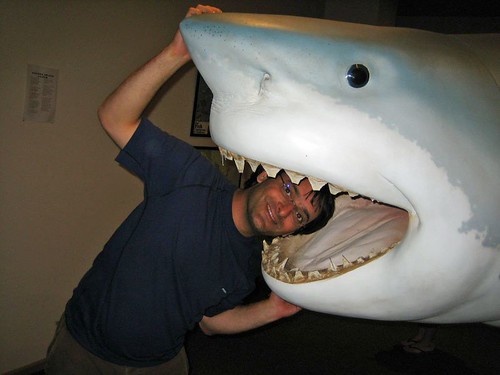
Surfing was a ton of fun, even if the sky was overcast and the wind was blowing. We next headed up the road to Ceduna to restock supplies for the next few nights.
Unfortunately, a late start, a long surf and an even longer lunch put us two hours behind schedule. We didn’t’ have time to stop at Cactus Beach, a famous surf break favored by the world champion surfer Kelly Slater.
We were also so behind schedule that I was unable to go sandboarding in Fowlers Bay, our stop for the night. I’d so been looking forward to shooting down a sand dune on a wooden board. Nevertheless, I’m on holiday and in no position to complain.
And then rain came.
I’ve mentioned how Victoria and South Australia have been suffering from drought, and the rain was a welcome sight for the locals. For our band of travelers, it meant a night camping under the unceasing pitter-patter of raindrops and a sodden morning packing wet tents. For a trip through the desert, this was turning into one soggy experience.
Next: the treeless plain, the camel-wombat-kangaroo sign, and a town covered by sand.
(Photos from the whole nine days are posted here. I will write the rest of the journey tomorrow.)
I came to Australia with the goal of crossing the Nullarbor. A solo traveler’s options for the Nullarbor are limited. Trains and buses make the journey in two days. You can rent a car and drive yourself. Or there’s the Nullarbor Travelller, a private tour company offering a nine-day tour from Adelaide to Perth with a few adventures along the way. I decided this was the best for me and signed up.
The world Nullarbor comes from the Latin Nullus Arbos, meaning treeless plain. The actual area of the Nullarbor that is treeless is just a fraction of the whole, but the area is still dry, hot and remote. It is the world’s largest, flattest piece of limestone, covering an area or approximately 200,000 square meters. The Aboriginal word for the region means “place without water.” Even today, large swaths of the Nullarbor generate their own electricity (from solar or wind power) and subsist on reserves of rainwater.

DAY ONE
The tour began with a 7 a.m. pickup at my hostel in Adelaide. The guide and driver is Kylie, a former hairdresser who decided to change careers and in her early 30’s finished high school, went to college for a degree in biodiversity and conservation and is now working as a guide until she can become a park ranger. Kylie dislikes of the city, “The Big Smoke” she calls it, and I can tell she is itching to get on the road. Her enthusiasm is infectious and soon her seven passengers are settled in for the adventure ahead.
Over the next nine days we will cover nearly 4,000 kilometers (2,500 miles), traveling through mountain ranges, coastal towns, desolate desert and old-growth forest.
We head north on A1, past farmland and dry salt lakes before reaching sleepy Port Germein to pick up our trailer – food, gear and general necessities for the road ahead. A few kilometers out of town we see the lower reaches of the Southern Flinders Ranges. Australians call these mountains, but with the highest peaks topping out at about 1,200 meters, most people (me, for one) would call them hills.
We stop at Mr. Remarkable for a short bushwalk while Kylie prepares lunch. It is here that I spot my first live kangaroos, unremarkable specimens we spook on the trail. I’ve seen plenty or ‘roos on film, but until I’d seen them hop with my own eyes, I didn’t understand the power of their legs and the grace with which they move. I have also learned (courtesy of the Lonely Planet guidebook) that the hopping motion assists in breathing, as the up and down motion jostles the intestines, which in turn pump the bellows of the lungs. After two weeks in Australia, I am happy to finally see these creatures. There will be many more before we reach Perth, but this is a load off my mind.

The afternoon also brings a change in scenery. The white limestone so prevalent on the coast gradually turns to a coppery red as we enter the inconsequential town of Port Augusta, once the center of the country’s mining industry. The town is also called the crossroads of Australia, with railroad and automobile routes north to Alice Springs and Darwin and west to Perth passing through. A quick stop for fuel and supplies (an overpriced bottle of Jack Daniels for me), we head to the defunct mine at Iron Knob.
With almost 800 kilometers to cover on the first day, I assume the tour’s operators wanted to break up the journey with something, with anything. What we get is a visit to the mine at Iron Knob. The town once housed 3,000 souls, but the land has been stripped bare and Iron Knob is little more than a historical curiosity. The visit is not something I would ever do on my own, but I enjoyed seeing a mine pit and the old machinery.
Next up is a short stop in Kimba, a town exactly halfway across the continent, for photos with another example of Australia’s oversized statues. This time it’s the big galah, a native bird with a shocking red breast. We also get our first look at road trains, the semi trucks carrying two or more trailers that ply Australia’s highways and dirt tracks. Road trains once carried up to seven trailers but are now limited to three on sealed roads and four on country tracks. At a Mobile Station outside of Kimba, the sign advertises the availability of petrol rather than the price.

We set up camp at Polda Rock, outside of Widunna. With a small group, there are tents for everyone and I am happy to know I will have a private room every night for the next week.
DAY TWO
The next morning, we drive an hour to Baird Bay, a protected cove where we sign up for the Baird Bay Ocean Eco Experience. It costs an extra $100 AUD, but I’m not about to pass up the chance to with wild sea lions and dolphins. The dolphins are skittish and swim away after about a minute, but the sea lions are happy to swim and play for about 40 minutes. (Click here for a detailed post on the swim).
After lunch on the beach in Baird Bay, we head to the geologic oddity Murphy’s Haystacks, where huge hunks of granite have been left exposed after hundreds of thousands of years of erosion. Good for pictures and the young geologist on the tour, but in the end not more than a curiosity. Kyle took me into the toilet to see a black widow, but it wasn’t in there, just egg sacks and a puny male.

The final activity of the day was a walk along the limestone cliffs at Venus Bay to see petrified trees, from a time when Australia and Antarctica were one landmass. Kylie also offered a lesson in identifying animal tracks in the sand. I can now spot a few kinds of lizard, snakes, emus and humans.
The second night we bunked at Coodlie Park, a ramshackle farmhouse operated by the owners of Nullarbor Traveller. A lukewarm shower, some electricity for my computer and a barbecue dinner completed a spectacular day in South Australia. From here on out it would be camping and tents every night.
DAY THREE
The third day of the tour started with a pleasant surprise: surf school. I grew up on the coast and tried to surf as a young teenager. I was never able to stand up and ride a wave. With a few simple instructions from Chris of Kingo Surfing, I entered the water and was standing up and riding waves in a matter of minutes. It helped that I was riding a huge soggy board. The fun of surfing, a private beach and clear green water took my mind off the great whites.

Surfing was a ton of fun, even if the sky was overcast and the wind was blowing. We next headed up the road to Ceduna to restock supplies for the next few nights.
Unfortunately, a late start, a long surf and an even longer lunch put us two hours behind schedule. We didn’t’ have time to stop at Cactus Beach, a famous surf break favored by the world champion surfer Kelly Slater.
We were also so behind schedule that I was unable to go sandboarding in Fowlers Bay, our stop for the night. I’d so been looking forward to shooting down a sand dune on a wooden board. Nevertheless, I’m on holiday and in no position to complain.
And then rain came.
I’ve mentioned how Victoria and South Australia have been suffering from drought, and the rain was a welcome sight for the locals. For our band of travelers, it meant a night camping under the unceasing pitter-patter of raindrops and a sodden morning packing wet tents. For a trip through the desert, this was turning into one soggy experience.
Next: the treeless plain, the camel-wombat-kangaroo sign, and a town covered by sand.
(Photos from the whole nine days are posted here. I will write the rest of the journey tomorrow.)

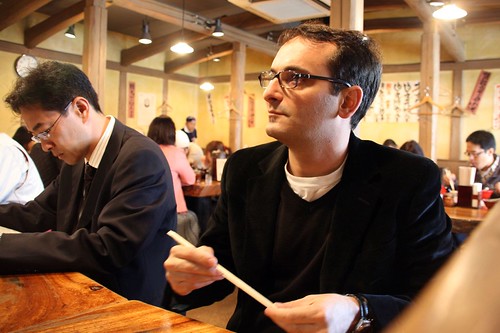

1 Comments:
Hi !
It's a really good job and a wonderful souvenir.
Thanks a lot !
Fred
Post a Comment
<< Home